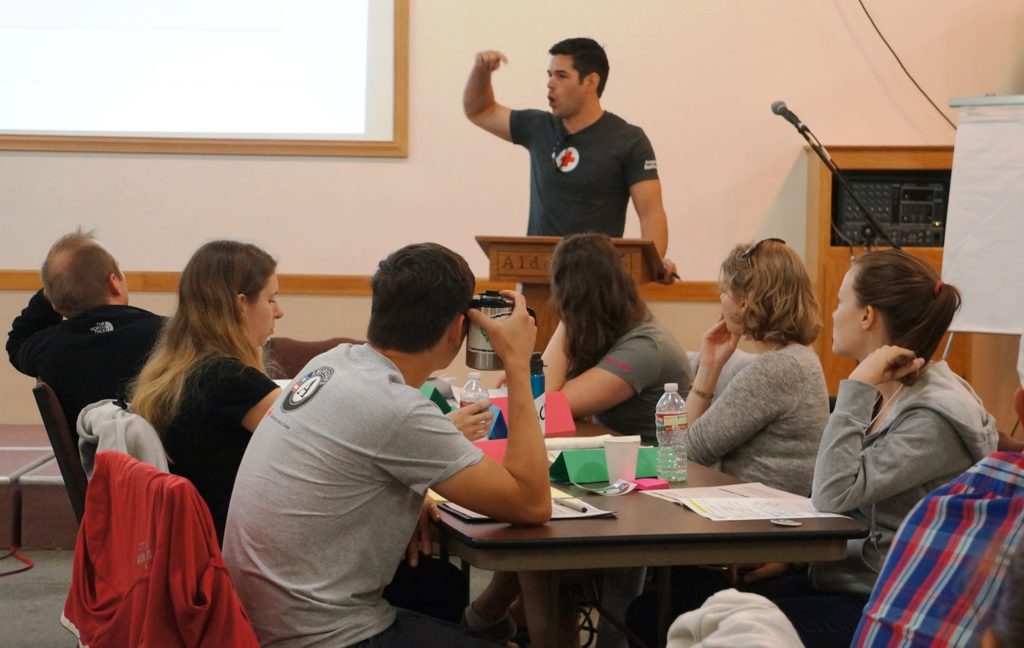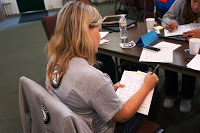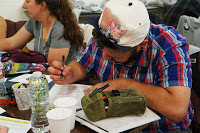Creating a State of Preparedness
On Wednesday, Sept. 4, more than 40 people from across the country met at a conference center in Turner, Ore. to learn about their new assignments in AmeriCorps, a national program designed to engage people in intensive community service work with the goal of “helping others and meeting critical needs in the community.” On the second day of this training, Red Cross Cascades Region Director of Emergency Preparedness Francisco Ianni discussed one of these critical needs – preparing communities for the next major disaster.
 |
| Francisco Ianni talks about the disaster threats facing Oregon and highlights the lack of overall preparedness |
Just four days into National Preparedness Month, Francisco spent the morning talking about major disaster risks such as the Cascadia Subduction Zone and the number of house fires Red Cross volunteers respond to each week. When asked if they had ever personally experienced an earthquake, a person from Alaska shared memories of ducking under desks in grade school, while a California transplant said while she experienced nearly weekly tremors at her home, her school did little to educate students on earthquake safety.
 |
| Emily Johnson takes her pre-preparedness test to find out what she already knows about disaster preparedness. |
Although not all new members could attend the orientation, there will be 63 AmeriCorps members in Oregon, five of which will serve their year at Red Cross community chapters. Other members will carry out a wide range of jobs such as helping homeless youth and facilitating community gardening. However, a special component of this years’ service program is that all 63 members are required to commit 10 percent of their time on disaster activity projects, such as delivering preparedness presentations and organizing earthquake drills.
 |
| Levi Johnson, an AmeriCorps member who will work at the Red Cross, seems to pass his post-test with flying colors |
According to Francisco, only 3 percent of Oregonians are considered first responders, meaning that in a major disaster, 3 percent of the population will need to take care of the remaining 97 percent of our population. Francisco wants to change that, and he wants AmeriCorps members to become preparedness leaders within their communities. At the end of the service year, he is confident that these individuals will make a real difference in the communities and leave a preparedness footprint in their paths.
4 comments
Wonderful information here, I will be the normal precise guest of the website and in addition delight in a person finding the time to keep your amazing world-class website Dental Implants
This piece of writing gives a lot of exceptional information and inspiration. Really a remarkable blog post I had seen Cosmetic Dentist
iParrot Post is a global read and reporting news platform that enable users to post their account of events witnessed, worthy local and International news. iParrot Post is a breaking news portal.iParrot Post exists to provide independent news and information to the masses, comprised of news feeds from around the world. We enable our users and subscribers to submit local News that they see as important. It is also a portal to allow users and subscribers to comment and contribute to the News events of the day. Worldwide News UK | English UK News | Local UK News | UK Political News | English British Sports News | Business UK News | Breaking UK News | Technology UK News |
Gentle article. I decided the online page additionally to require to be told I required extremely seeking your website publicity. Hot Tub Covers Alberta
Comments are closed.